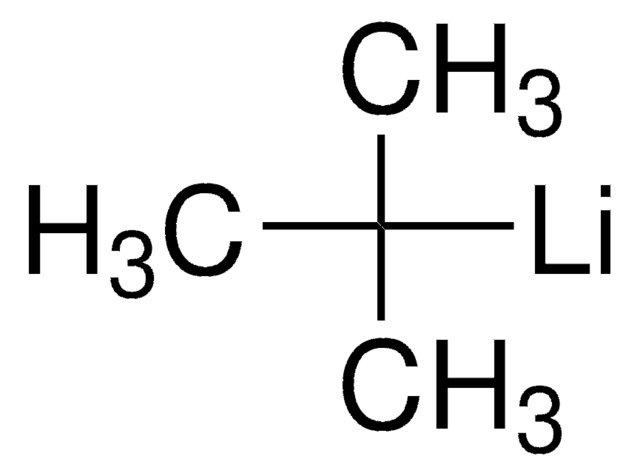577014
Lithium bis(trimethylsilyl)amide solution
1 M in tert-butyl methyl ether
Synonym(s):
Hexamethyldisilazane lithium salt
Sign Into View Organizational & Contract Pricing
All Photos(1)
About This Item
Linear Formula:
[(CH3)3Si]2NLi
CAS Number:
Molecular Weight:
167.33
Beilstein:
3567910
MDL number:
UNSPSC Code:
12352111
PubChem Substance ID:
NACRES:
NA.22
Recommended Products
Quality Level
concentration
1 M in tert-butyl methyl ether
SMILES string
[Li]N([Si](C)(C)C)[Si](C)(C)C
InChI
1S/C6H18NSi2.Li/c1-8(2,3)7-9(4,5)6;/h1-6H3;/q-1;+1
InChI key
YNESATAKKCNGOF-UHFFFAOYSA-N
Looking for similar products? Visit Product Comparison Guide
Related Categories
Signal Word
Danger
Hazard Statements
Precautionary Statements
Hazard Classifications
Eye Dam. 1 - Flam. Liq. 2 - Self-heat. 1 - Skin Corr. 1B
Supplementary Hazards
Storage Class Code
4.2 - Pyrophoric and self-heating hazardous materials
WGK
WGK 2
Flash Point(F)
-13.0 °F - closed cup
Flash Point(C)
-25 °C - closed cup
Personal Protective Equipment
dust mask type N95 (US), Eyeshields, Gloves
Choose from one of the most recent versions:
Already Own This Product?
Find documentation for the products that you have recently purchased in the Document Library.
Customers Also Viewed
Daniele Fabbri et al.
Environmental science & technology, 42(8), 2957-2963 (2008-05-24)
Using the pyrolysis-gas chromatography-mass spectrometry and off-line pyrolysis/silylation methods for lignites from three Miocene brown coal basins of Poland resulted in the characterization of many organic compounds, including dominant cellulose degradation products such as levoglucosan, 1,6-anhydro-beta-D-glucofuranose, and 1,4:3,6-dianhydroglucopyranose. Levoglucosan is
A Sebok et al.
Journal of chromatography. A, 1211(1-2), 104-112 (2008-10-14)
This paper presents a derivatization, mass fragmentation study relating to the most common six cholic acids, such as cholic, lithocholic, chenodeoxycholic, ursodeoxycholic, 3-hydroxy,7-ketocholanic and dehydrocholic acids, identified and quantified as pollutants in the aquatic environment at the first time. Derivatizations
Adrienne C Greene et al.
Biomaterials, 32(34), 8860-8869 (2011-09-03)
Chemical and topographical cues can be used to guide dissociated neurons into user-defined network geometries on artificial substrates, yet control of neuron polarity (differentiation into axons and dendrites) remains an elusive goal. We developed a dual guidance cue strategy for
Marko Marinkovic et al.
Advanced materials (Deerfield Beach, Fla.), 24(29), 4005-4009 (2012-06-26)
A model is presented that describes the gate-voltage-dependent contact resistance and channel-length-dependent charge carrier mobility of small-molecule-based organic thin-film transistors in top and bottom drain/source contact configuration.
Xinfeng Zhang et al.
Langmuir : the ACS journal of surfaces and colloids, 26(22), 16828-16832 (2010-10-06)
Two-dimensional silica nanoparticle assemblies were obtained by deposition of bubble made from a surfactant solution containing nanoparticles onto hydrophobic silicon substrate. The morphologies of the nanoparticle assemblies can be finely controlled by several experimental parameters, including surfactant concentration, nanoparticle concentration
Our team of scientists has experience in all areas of research including Life Science, Material Science, Chemical Synthesis, Chromatography, Analytical and many others.
Contact Technical Service







